Experimental Analysis of the Mechanical Properties and Failure Behavior of Deep Coalbed Methane Reservoir Rocks
Abstract
:1. Introduction
2. Mineral Content and Microstructure Analysis of DCMRR
3. Analysis of the Mechanical Properties of DCMRR
3.1. Experimental Process
3.2. Experimental Result Analysis
4. Effects of Fracturing Fluid and Drilling Fluid on the Mechanical Properties of Coal Seam Rocks
4.1. Rock Immersion Experimental Procedure
4.2. Effect of Drilling Fluid on Coal Seam Rocks
4.3. Effect of Fracturing Fluid on Coal Seam Rocks
5. Conclusions
- (1)
- The roof of the coal seam is composed of deep gray argillaceous limestone with a calcite content exceeding 90%, while the floor consists of dark gray carbonaceous mudstone with a clay mineral content exceeding 60%. The rock in the coal seam section is dominated by clay minerals and amorphous substances. The clay minerals in both the roof, floor, and coal seam section primarily consist of kaolinite, and the content of montmorillonite is extremely low, making it less prone to hydration dispersion. Microcracks and pores are developed in the coal seam, facilitating the establishment of natural gas permeation pathways. However, these internal spaces may be filled with sheet-like kaolinite aggregates that are susceptible to hydration expansion.
- (2)
- The roof and floor of the coal seam are relatively dense and hard, exhibiting strong elasticity and compressive strength, with a more uniform fracture pattern after compression. In contrast, the rocks in the coal seam section have lower compressive strength and show pronounced plastic deformation characteristics. After compression-induced failure, fractures tend to extend along coal cleats, resulting in a distribution of fractures that intersects both longitudinally and transversely.
- (3)
- The content of kaolinite exhibits a notable correlation with the mechanical properties of DCMRR. As the kaolinite content increases, the compressive strength and elastic modulus of DCMRR decrease, while the Poisson’s ratio increases. The presence of kaolinite weakens the strength of DCMRR, and higher kaolinite content is associated with more pronounced deformation capabilities and greater water absorption expansion in the rock. During the horizontal drilling process, it is advisable to keep the wellbore trajectory as close to the roof of the coal seam as possible to minimize the risk of borehole collapse.
- (4)
- Under the immersion of drilling fluid and slickwater, the strength of the coal seam rock is significantly reduced. After the rock undergoes compressive failure, shear fracture zones and localized strong damage characteristics may appear. During the drilling process, precautions should be taken to prevent the risk of borehole collapse caused by the immersion of drilling fluid in the rock. Enhancing the hydration effect of slickwater on coal seam rock may contribute to the formation of a complex fracture network in the deep coalbed methane reservoir.
Author Contributions
Funding
Data Availability Statement
Conflicts of Interest
References
- Zhao, J.; Ren, L.; Jiang, T.; Hu, D.; Wu, L.; Wu, J.; Yin, C.; Li, Y.; Hu, Y.; Lin, R.; et al. Ten years of gas shale fracturing in China: Review and prospect. Nat. Gas Ind. B 2022, 9, 158–175. [Google Scholar] [CrossRef]
- Zhang, J.; Tan, Y.; Zhang, T.; Yu, K.; Wang, X.; Zhao, Q. Natural gas market and underground gas storage development in China. J. Energy Storage 2020, 29, 101338. [Google Scholar] [CrossRef]
- Qin, Y.; Moore, T.A.; Shen, J.; Yang, Z.; Shen, Y.; Wang, G. Resources and geology of coalbed methane in China: A review. In Coal Geology of China; Routledge: London, UK, 2020; pp. 247–282. [Google Scholar]
- Li, S.; Qin, Y.; Tang, D.; Shen, J.; Wang, J.; Chen, S. A comprehensive review of deep coalbed methane and recent developments in China. Int. J. Coal Geol. 2023, 279, 104369. [Google Scholar] [CrossRef]
- Wang, H.; Yang, S.; Zhou, D.; Wang, Q. Influence of non-intersecting cemented natural fractures on hydraulic fracture propagation behavior. J. Struct. Geol. 2024, 181, 105111. [Google Scholar] [CrossRef]
- Jiang, W.; Zhang, P.; Li, D.; Li, Z.; Wang, J.; Duan, Y.; Wu, J.; Liu, N. Reservoir characteristics and gas production potential of deep coalbed methane: Insights from the no. 15 coal seam in shouyang block, Qinshui Basin, China. Unconv. Resour. 2022, 2, 12–20. [Google Scholar] [CrossRef]
- Wei, Q.; Hu, B.; Li, X.; Feng, S.; Xu, H.; Zheng, K.; Liu, H. Implications of geological conditions on gas content and geochemistry of deep coalbed methane reservoirs from the Panji Deep Area in the Huainan Coalfield, China. J. Nat. Gas Sci. Eng. 2021, 85, 103712. [Google Scholar] [CrossRef]
- Li, S.; Tang, D.; Pan, Z.; Xu, H.; Tao, S.; Liu, Y.; Ren, P. Geological conditions of deep coalbed methane in the eastern margin of the Ordos Basin, China: Implications for coalbed methane development. J. Nat. Gas Sci. Eng. 2018, 53, 394–402. [Google Scholar] [CrossRef]
- Sun, F.; Liu, D.; Cai, Y.; Qiu, Y. Coal rank-pressure coupling control mechanism on gas adsorption/desorption in coalbed methane reservoirs. Energy 2023, 270, 126849. [Google Scholar] [CrossRef]
- Yong, Q. Progress on geological research of deep coalbed methane in China. Acta Pet. Sin. 2023, 44, 1791–1811. [Google Scholar]
- Hou, L.; Liu, X.; Liang, L.; Xiong, J.; Zhang, P.; Xie, B.; Li, D. Investigation of coal and rock geo-mechanical properties evaluation based on the fracture complexity and wave velocity. J. Nat. Gas Sci. Eng. 2020, 75, 103133. [Google Scholar] [CrossRef]
- Tao, C.; Li, Y.; Wang, Y.; Ni, X.; Wu, X.; Zhao, S. Characteristics of Deep Coal Reservoir and Key Control Factors of Coalbed Methane Accumulation in Linxing Area. Energies 2023, 16, 6085. [Google Scholar] [CrossRef]
- Liu, S.; Fan, K.; Jin, Y.; Yu, Z.; Dong, J.; Wang, C. Stress sensitivity characteristics of deep coal reservoirs and its influence on coalbed methane productivity. Coal Geol. Explor. 2022, 50, 56–64. [Google Scholar]
- Zhang, G.; He, S.; Tang, M.; Kong, L. The mechanism and countermeasures of inclined well wellbore instability in Dibei deep coal seam. J. Pet. Explor. Prod. Technol. 2022, 12, 2833–2848. [Google Scholar] [CrossRef]
- Xie, S.; Wang, E.; Chen, D.; Li, H.; Jiang, Z.; Yang, H. Stability analysis and control technology of gob-side entry retaining with double roadways by filling with high-water material in gently inclined coal seam. Int. J. Coal Sci. Technol. 2022, 9, 52. [Google Scholar] [CrossRef]
- Reisabadi, M.Z.; Haghighi, M.; Salmachi, A.; Sayyafzadeh, M.; Khaksar, A. Analytical modelling of coal failure in coal seam gas reservoirs in different stress regimes. Int. J. Rock Mech. Min. Sci. 2020, 128, 104259. [Google Scholar] [CrossRef]
- Marsden, H.; Basu, S.; Striolo, A.; MacGregor, M. Advances of nanotechnologies for hydraulic fracturing of coal seam gas reservoirs: Potential applications and some limitations in Australia. Int. J. Coal Sci. Technol. 2022, 9, 27. [Google Scholar] [CrossRef]
- Li, R.; Wang, S.; Li, G.; Wang, J. Influences of coal seam heterogeneity on hydraulic fracture geometry: An in situ observation perspective. Rock Mech. Rock Eng. 2022, 55, 4517–4527. [Google Scholar] [CrossRef]
- Wang, H.; Zhou, D. Mechanistic study on the effect of seepage force on hydraulic fracture initiation. Fatigue Fract. Eng. Mater. Struct. 2024, 47, 1602–1619. [Google Scholar] [CrossRef]
- Ahamed, M.A.; Perera, M.S.; Li, D.-Y.; Ranjith, P.G.; Matthai, S.K. Proppant damage mechanisms in coal seam reservoirs during the hydraulic fracturing process: A review. Fuel 2019, 253, 615–629. [Google Scholar] [CrossRef]
- Mishra, B.; Nie, D. Experimental investigation of the effect of change in control modes on the post-failure behavior of coal and coal measures rock. Int. J. Rock Mech. Min. Sci. 2013, 60, 363–369. [Google Scholar] [CrossRef]
- Wang, K.; Du, F.; Zhang, X.; Wang, L.; Xin, C. Mechanical properties and permeability evolution in gas-bearing coal–rock combination body under triaxial conditions. Environ. Earth Sci. 2017, 76, 815. [Google Scholar] [CrossRef]
- Xie, H.; Gao, M.; Zhang, R.; Peng, G.; Wang, W.; Li, A. Study on the mechanical properties and mechanical response of coal mining at 1000 m or deeper. Rock Mech. Rock Eng. 2019, 52, 1475–1490. [Google Scholar] [CrossRef]
- Yao, Q.; Zheng, C.; Tang, C.; Xu, Q.; Chong, Z.; Li, X. Experimental investigation of the mechanical failure behavior of coal specimens with water intrusion. Front. Earth Sci. 2020, 7, 348. [Google Scholar] [CrossRef]
- Ma, B.; Wang, F.; Liu, H.; Yin, D.; Xia, Z. Mechanical properties of rock–coal–rock composites at different inclined coal seam thicknesses. Front. Phys. 2022, 9, 806055. [Google Scholar] [CrossRef]
- Wang, Y.; Xie, H.; Chen, S. Petrophysical and Mechanical Properties of Complex Structure Coalbed Methane Reservoir: A Laboratory Investigation. Rock Mech. Rock Eng. 2023, 56, 69–87. [Google Scholar] [CrossRef]
- Miranda-Trevino, J.C.; Coles, C.A. Kaolinite properties, structure and influence of metal retention on pH. Appl. Clay Sci. 2003, 23, 133–139. [Google Scholar] [CrossRef]
- Wang, Y.; Liu, X.; Liang, L.; Xiong, J. Experimental study on the damage of organic-rich shale during water-shale interaction. J. Nat. Gas Sci. Eng. 2020, 74, 103103. [Google Scholar] [CrossRef]
- Zhao, P.; Fan, X.; Zhang, Q.; Yao, B.; Zhang, M.; He, L.; Qiang, Y.; Liu, J. Characteristics of hydration damage and its influence on permeability of lamellar shale oil reservoirs in Ordos Basin. Geofluids 2021, 2021, 6646311. [Google Scholar] [CrossRef]
- Zhang, Q.; Fan, X.; Chen, P.; Ma, T.; Zeng, F. Geomechanical behaviors of shale after water absorption considering the combined effect of anisotropy and hydration. Eng. Geol. 2020, 269, 105547. [Google Scholar] [CrossRef]

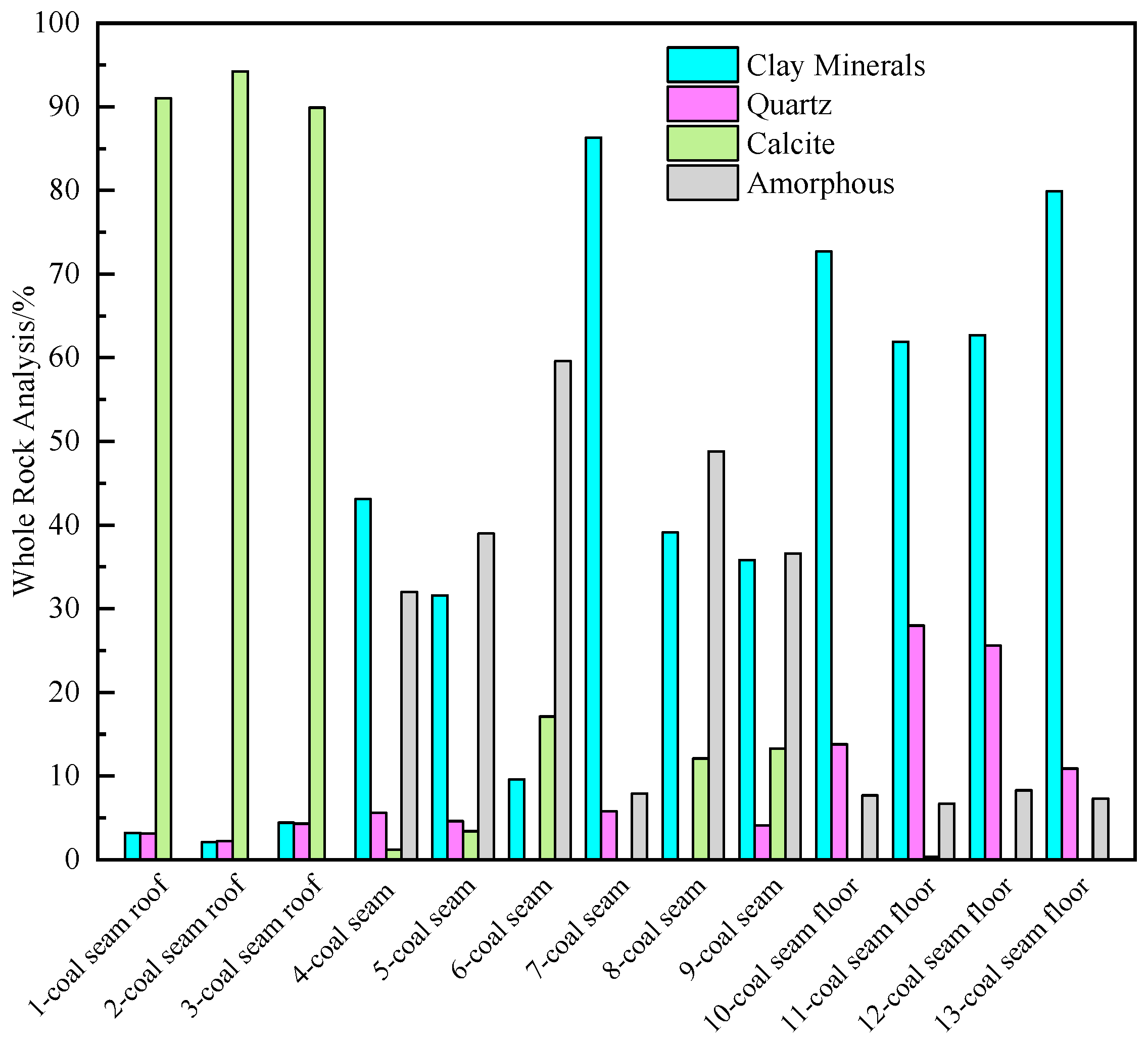
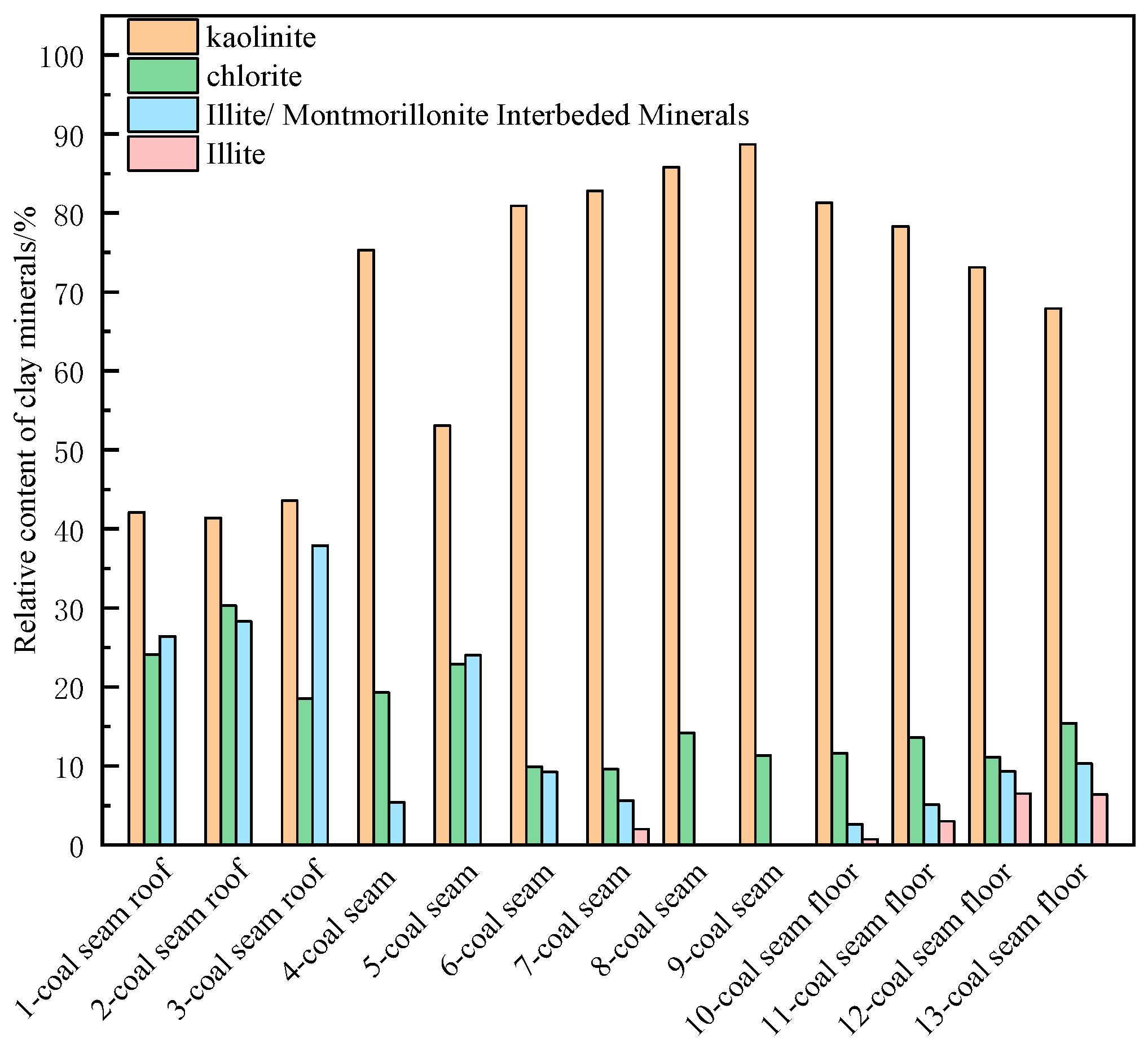
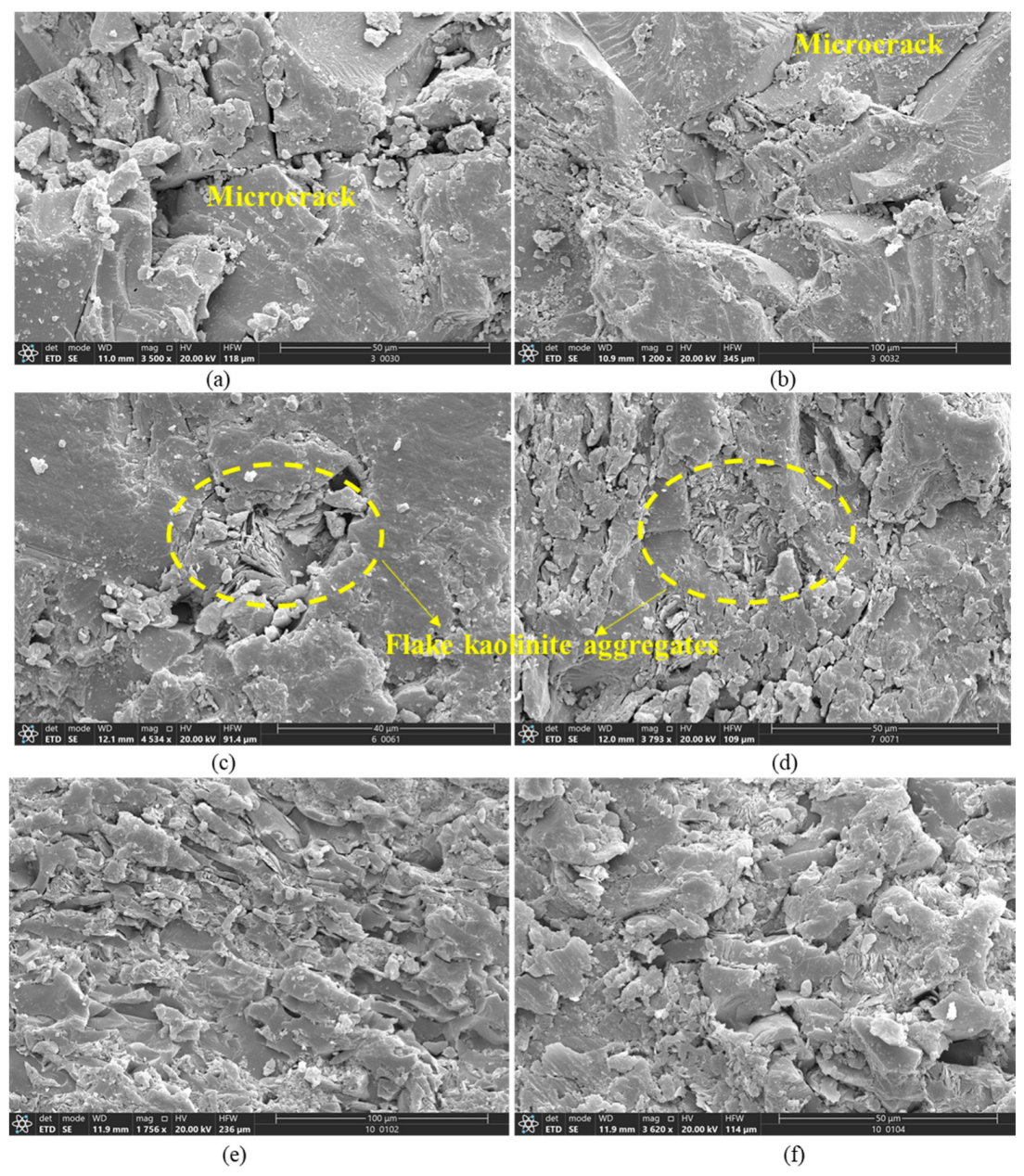
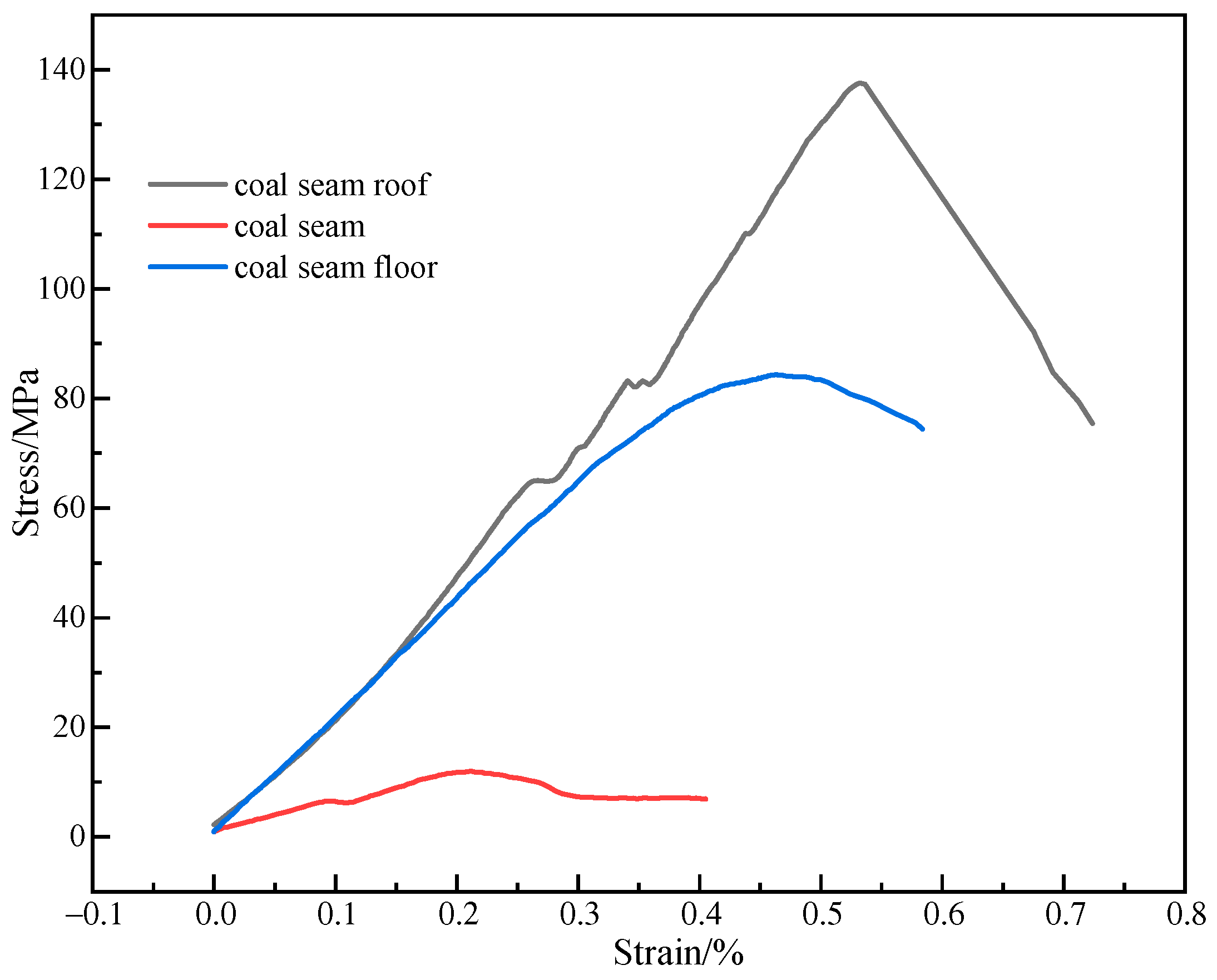


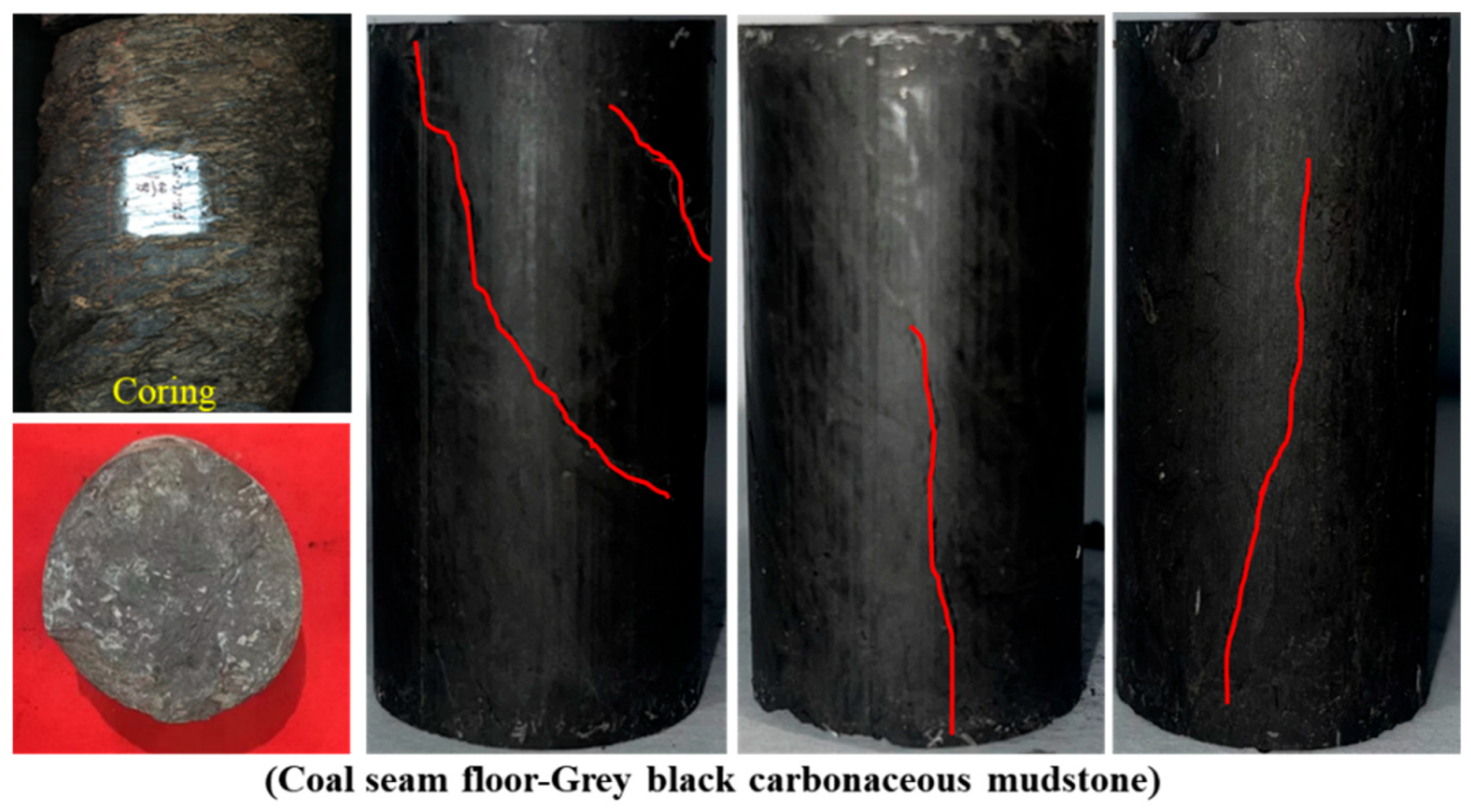
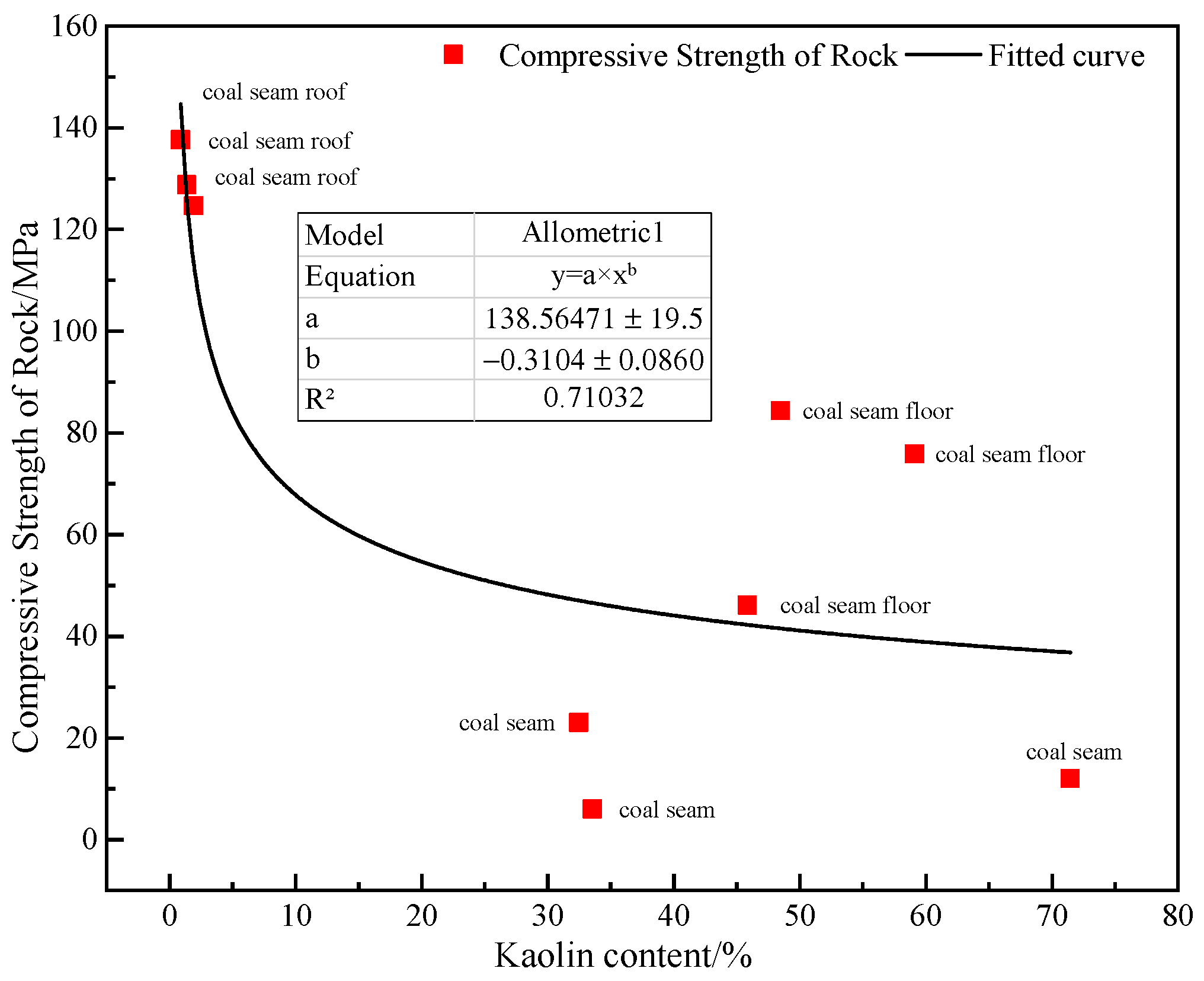
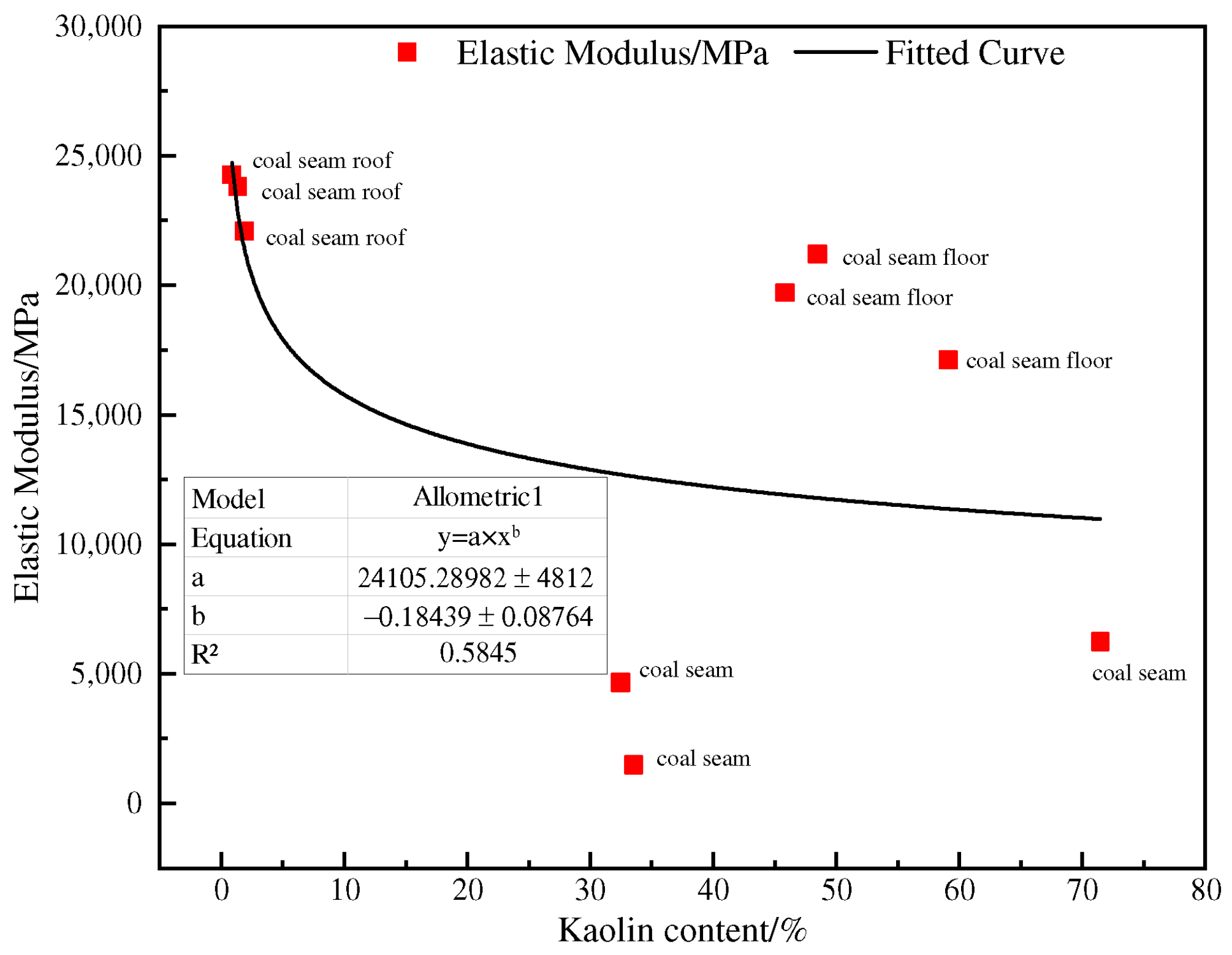

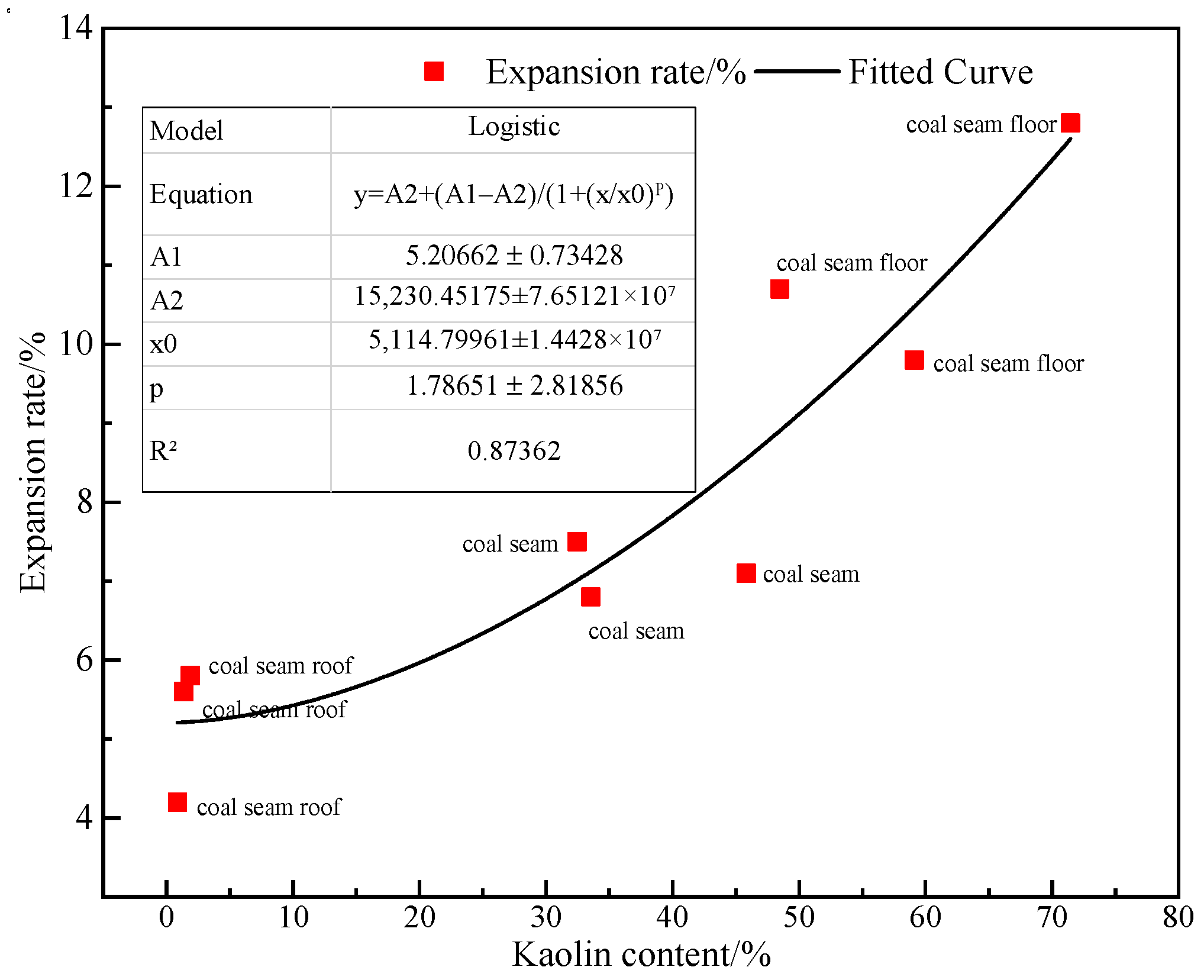
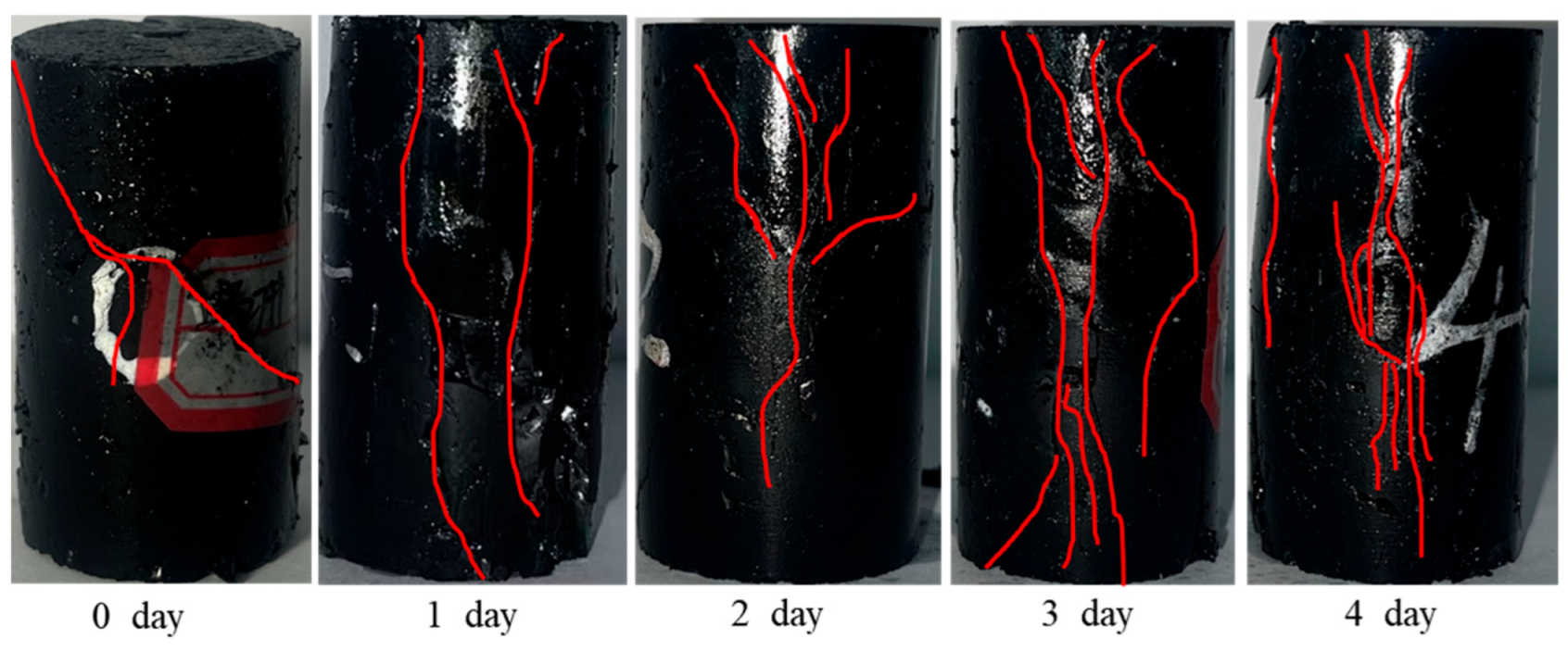






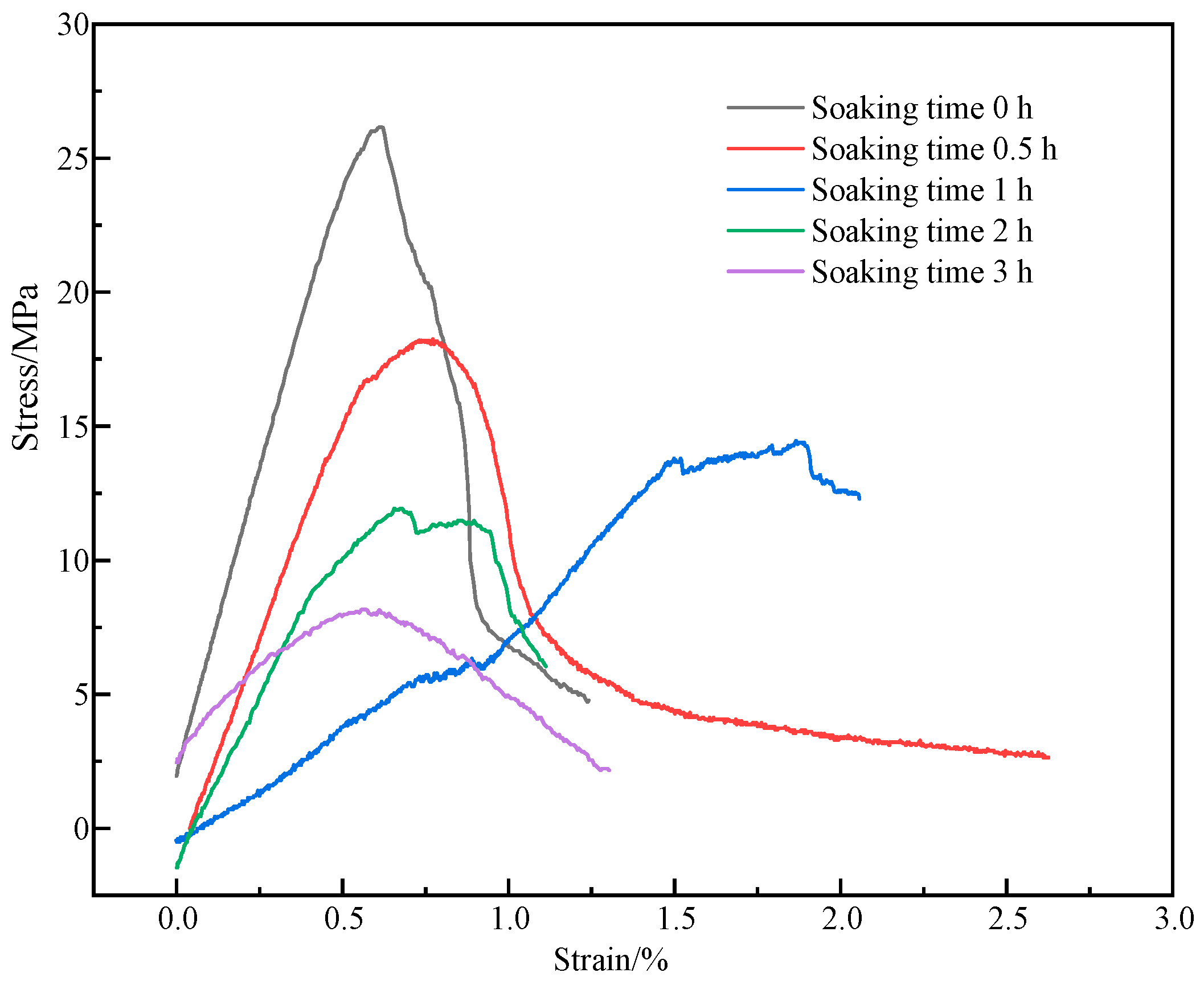
| Number | Rock Property | Elasticity Modulus/MPa | Poisson’s Ratio | Compressive Strength/MPa |
|---|---|---|---|---|
| 1 | Coal seam roof | 23,804.35 | 0.13 | 128.78 |
| 2 | Coal seam roof | 22,080.39 | 0.17 | 124.67 |
| 3 | Coal seam roof | 24,264.17 | 0.15 | 137.60 |
| 4 | Coal seam | 4665.02 | 0.32 | 23.04 |
| 5 | Coal seam | 6230.87 | 0.42 | 12.02 |
| 6 | Coal seam | 1479.86 | 0.41 | 6.07 |
| 7 | Coal seam floor | 17,105.68 | 0.19 | 75.87 |
| 8 | Coal seam floor | 21,198.39 | 0.21 | 84.39 |
| 9 | Coal seam floor | 19,708.39 | 0.26 | 46.16 |
Disclaimer/Publisher’s Note: The statements, opinions and data contained in all publications are solely those of the individual author(s) and contributor(s) and not of MDPI and/or the editor(s). MDPI and/or the editor(s) disclaim responsibility for any injury to people or property resulting from any ideas, methods, instructions or products referred to in the content. |
© 2024 by the authors. Licensee MDPI, Basel, Switzerland. This article is an open access article distributed under the terms and conditions of the Creative Commons Attribution (CC BY) license (https://creativecommons.org/licenses/by/4.0/).
Share and Cite
Wang, H.; Yang, S.; Zhang, L.; Xiao, Y.; Su, X.; Yu, W.; Zhou, D. Experimental Analysis of the Mechanical Properties and Failure Behavior of Deep Coalbed Methane Reservoir Rocks. Processes 2024, 12, 1125. https://doi.org/10.3390/pr12061125
Wang H, Yang S, Zhang L, Xiao Y, Su X, Yu W, Zhou D. Experimental Analysis of the Mechanical Properties and Failure Behavior of Deep Coalbed Methane Reservoir Rocks. Processes. 2024; 12(6):1125. https://doi.org/10.3390/pr12061125
Chicago/Turabian StyleWang, Haiyang, Shugang Yang, Linpeng Zhang, Yunfeng Xiao, Xu Su, Wenqiang Yu, and Desheng Zhou. 2024. "Experimental Analysis of the Mechanical Properties and Failure Behavior of Deep Coalbed Methane Reservoir Rocks" Processes 12, no. 6: 1125. https://doi.org/10.3390/pr12061125





